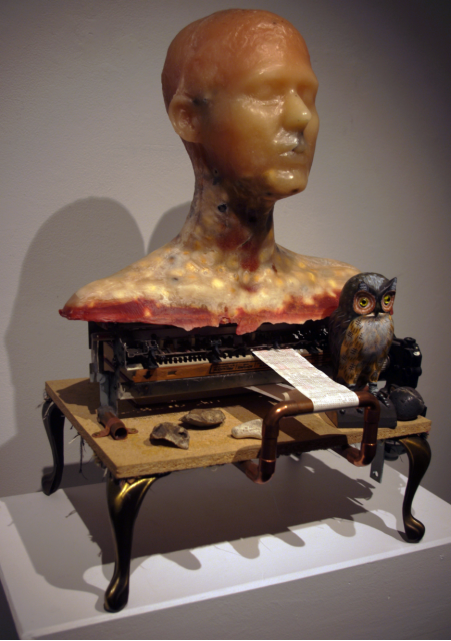By Beau O’Neill (Contributor) – Email
Print Edition: January 30, 2013
Starting clockwise in the gallery for the sake of systematics, we have a piece of cardboard, spray painted with a stencil of what appears to be Lev Tolstoy, Father of Russian literature, legs crossed, hands laid on right knee in the posture of a thinking man who is also an understanding man. Scribbled there first, under the archeology of Tolstoy, was the word “Fragile,” but the bearded head covers the “g” and the “i.” A bright yellow arrow is glued or taped beside the seated figure, pointing up. And in the lower left corner is a neatly packed square of dirt with a molded nose coming off it, smelling the room. This first piece smells sweetly of the rest of the collection.
Why I gave you such a description of one of Scott Schell’s pieces from his exhibit Listen as the Whispers Look Around presented on UFV’s Abbotsford campus is because it is an exhibition of phenomena that are grounded, in more ways than one, by their context as much as by their complexity. It is because this is a simpler but rich piece that I have chosen to describe it to you, even though I left out the detail about the many strands of masking tape that rush into the work from the edges, geometrically, or the urge that one gets upon looking at it to flip over the cardboard and see what may be on the other side.
The fact that a man without interests like those in The Da Vinci Code would want to look on the other side of a piece of art speaks loads about the complexity of the creations. These are multidimensional works that are overdetermined in the possibilities of meaning. That’s not saying these pieces are vague, but that they are fecund.
In the next piece, a larger patch of sawdust centres the work, and a nose lies in its middle. The tamping of the material around the cement prosthetic suggests the features of a face, but that sort of conjecturing occurs frequently as the viewer peers into the many facets of each piece. A dried honeycomb is glued top left, a hermit crab shell is suspended in a glass case surrounded by a white background near the bottom, and a plaque bearing the designation “WESTERN HEMLOCK/ Tsuga heterophilla/ RANGE/ N.W. NORTH AMERICA” ironically draws our attention to the nose in the sawdust. The plaque is now an epitaph.
The pieces show nature struggling through the layer of humanity and artifice which we have smothered much of the world in: twigs and dirt pushing out of a wall socket, a canvas of sawdust and noses, an ear poking through the tide on rippled sand, stone toes resting beside stones on a stream bank. The placing of replicas of human body parts within nature comes in the form of poster-sized photographs. What would be the natural environment for these objects? Is it the soft moss of the forest floor, the pulverized beach stone or the white display pillar upon which some more colourful pieces rest?
Though the casts are the unifying theme of the exhibit, there are also collages which work like object-poems, multimedia collaborations (including a canvas covered in shoes, paint, string and the sawdust-with-nose), and an even more fascinating piece that utilizes the guts of a typewriter-like machine, encyclopedias, brass tubing, a mottled bust, particle board, rocks, an owl statue and ornate metal legs.
Investigation of this last piece proved worthwhile: looking closely at the gibberish of “1”s and “0”s on a piece of receipt paper, I found, among others, the words, “DADA,” “BIRD,” “AUSTRALOPITHECUS,” and on the other bottom side “Homo E SAPAIN.” The mistake in our species doesn’t matter – how much do we know correctly about it anyway? It was richly rewarding to find so much in the hidden recesses of this piece, literally spelling out its influences and ancestors.
The exhibit is interesting and Schell’s “ongoing project,” which has the concrete casts of body parts placed in public locations, is excitingly bringing art into the living world. Maybe next time you find a foot on a river bank you will think “Scott Schell” and not “BC foot mystery evidence.”



